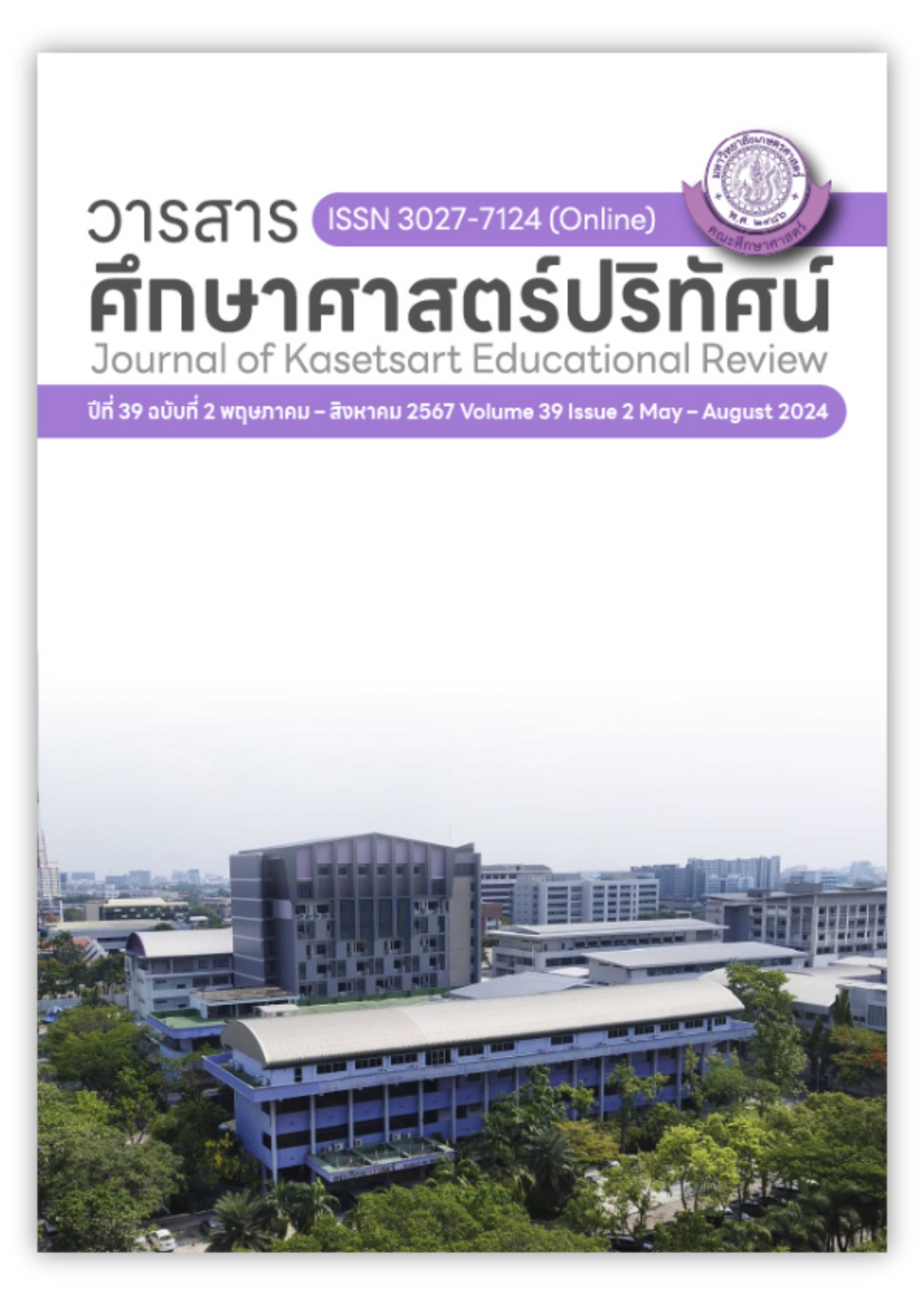การพัฒนาชิ้นงานและเกณฑ์การให้คะแนนเพื่อประเมินความคิดสร้างสรรค์ทางศิลปะของนักเรียนระดับประถมศึกษา
คำสำคัญ:
การประเมินชิ้นงานศิลปะ, เกณฑ์การให้คะแนนความคิดสร้างสรรค์ทางศิลปะ, ทฤษฎีสรุปอ้างอิงความเชื่อถือของผลการวัดบทคัดย่อ
การวิจัยนี้มีวัตถุประสงค์เพื่อสร้างชิ้นงานและเกณฑ์การให้คะแนนความคิดสร้างสรรค์ทางศิลปะของนักเรียนระดับประถมศึกษา และตรวจสอบคุณภาพชิ้นงานและเกณฑ์การให้คะแนนโดยใช้ทฤษฎีสรุปอ้างอิงความน่าเชื่อถือของผลการวัด โดยกลุ่มตัวอย่างเป็นนักเรียนระดับประถมศึกษา จำนวน 180 คน รูปแบบการศึกษาการสรุปอ้างอิงเป็นแบบ p x t x r เมื่อ p แทนนักเรียน t แทนชิ้นงาน และ r แทนผู้ตรวจ เครื่องมือวิจัย คือ ชิ้นงานศิลปะและเกณฑ์การให้คะแนนความคิดสร้างสรรค์ทางศิลปะตามแนวคิดของสเติร์นเบอร์ก วิเคราะห์ข้อมูลโดยหาค่าเฉลี่ย ส่วนเบี่ยงเบนมาตรฐาน ความเที่ยงระหว่างผู้ประเมิน และสัมประสิทธิ์ความเที่ยงตามทฤษฎีสรุปอ้างอิง
ผลการวิจัยพบว่า 1) ชิ้นงานและเกณฑ์การให้คะแนนความคิดสร้างสรรค์ทางศิลปะ (ทัศนศิลป์) มีดัชนีความตรงเชิงเนื้อหา 1.0 ค่าอำนาจจำแนกอยู่ระหว่าง .46 - .66 ค่าความยากอยู่ระหว่าง .38 - .46 และค่าความเที่ยงระหว่างผู้ประเมิน .78 2) ผลการประมาณค่าความแปรปรวน พบว่า องค์ประกอบความแปรปรวนของด้านนักเรียนมีความแปรปรวนมากที่สุด (58.53%) และ 3) ผลการประมาณค่าสัมประสิทธิ์การสรุปอ้างอิงความน่าเชื่อถือของผลการวัด พบว่า ค่าสัมประสิทธิ์ความน่าเชื่อถือของผลการวัดที่ยอมรับได้สำหรับการตัดสินใจเชิงสัมพัทธ์และเชิงสัมบูรณ์ ( = .84,
= .83) เสนอว่า ในการวัดความคิดสร้างสรรค์ทางศิลปะให้แม่นยำที่ยอมรับได้ นักเรียนควรทำชิ้นงาน 3 ชิ้น และได้รับการประเมินด้วยครู 2 คน
เอกสารอ้างอิง
Alabbasi, A. M., Paek, S. H., Kim, D., & Cramond, B. (2022). What do educators need to know about the Torrance Tests of Creative Thinking: A comprehensive review. Front. Psychol. 13. https://doi.org/10.3389/fpsyg.2022.1000385
Atilgan, H. (2013). Sample Size for Estimation of G and Phi Coefficient in Generalizability Theory. Eurasiam Journal of Educational Research, 51, 215-228.
Barabasch, A. (2020). Creativity and arts-based learning. Journal of Adult and Continuing Education, 26(1), 3-5.
Barbot, B., Besancon, M., & Lubart, T. (2011). Assessing Creativity. The Open Education Journal, 2011, 4, 58-66. https://doi.org/10.1080/03004279.2015.1020643
Bart, W. M., Hokanson, B., & Can, I. (2017). An Investigation of the Factor Structure of the Torrance Tests of Creative Thinking. Educational Sciences: Theory & Practice, 17(2), 515-528. https://doi.org/10.12738/estp.2017.2.0051
Changwa, P. & Tuksino, P. (2023). The comparison of reliability and validity of the raters' scoring criteria with different characteristics of raters of essay tests for measuring scientific competence of grade 9 students. Journal of education measurement Mahasarakham University, 29(1), 133-147. [in Thai]
Earnshaw, R. (2023). Introduction. In: Creativity in Art, Design and Technology. Springer Series on Cultural Computing. Springer, Cham. https://doi.org/10.1007/978-3-031-24869-6_1
Eisner, E. (1976). Educational Connoisseurship and Criticism: Their Form and Functions in Educational Evaluation. The Journal of Aesthetic Education, 10(3), 135-156.
Fleiss, J. L., Levin, B., & Paik, M. C. (2003). The Measurement of Interrater Agreement. In J. L. Fleiss, B. Levin & M. C. Paik (Eds.), Statistical methods for rates and proportions (3rd ed.). (pp. 598-626). John Wiley & Sons. https://doi.org/10.1002/0471445428.ch18
Kanli, E. (2020). Assessment of Creativity: Theories and Methods. IntechOpen. https://doi.org/10.5772/intechopen.93971
Kongprapan, R. (2023). Development of reading ability assessment model for grade 1 students: an application of generalizability theory [Unpublished doctoral dissertation]. Naresuan University. [in Thai]
Krumm, G., Lemos, V., & Filippetti, V. A. (2014). Factor structure of the Torrance tests of creative thinking figural Form B in Spanish-speaking children: Measurement invariance across gender. Creativity Research Journal, 26(1), 72–81.
Matharach, S. & Tuksino, P. (2023). Quality comparison of scoring of essay tests to measure mathematics problem solving ability using different scoring designs: application of generalizability theory. Journal of education measurement Mahasarakham University, 29(1), 274-290. [in Thai]
McCaffrey, D.F., Oliveri, M.E. and Holtzman, S. (2018), A Generalizability Theory Study to Examine Sources of Score Variance in Third-Party Evaluations Used in Decision-Making for Graduate School Admissions. ETS Research Report Series, 2018,1-17. https://doi.org/10.1002/ets2.12225
McTighe, J. (2015, April). What is a Performance Task? (Part 1). https://blog.performancetask.com/what-is-a-performance-task-part-1-9fa0d99ead3b
Metwaly, S. S., Noortgate, W., & Kyndt, E. (2017). Approaches to Measuring Creativity: A Systematic Literature Review. Creativity. De Gruyter, 4(2), 238-275.
Nakorn, N. N. (2018). Methods for measuring and evaluating thinking based on real conditions. Bangkok: Santisiri Printing House. [in Thai].
Nathan, L. F. (2019). Creativity, the Arts, and the Future of Work. In Cook, J.W. (Eds). Sustainability, Human Well-Being, and the Future of Education (pp.283-310). Palgrave Macmillan, Cham.
Pelowski, M., Ledar, H., & Tinio, P. P. L. (2017). Creativity in the Visual Arts. In J. C. Kaufman, V. P. Glăveanu, & J. Baer (Eds.), The Cambridge handbook of creativity across domains (pp. 80–109). Cambridge University Press. https://doi.org/10.1017/9781316274385.006
Plucker, J. A., & Beghetto, R. A. (2004). Why creativity is domain general, why it looks domain specific, and why the distinction does not matter. In R. J. Sternberg, E. L. Grigorenko, & J. L. Singer (Eds.), Creativity: From Potential to Realization (pp. 153-167). American Psychological Association. http://dx.doi.org/10.1037/10692-009
Runco, M. A., & Jaeger, G. J. (2012). The standard definition of creativity. Creativity Research Journal, 24(1), 92–96. https://doi.org/10.1080/10400419.2012.650092
Sanguanwai, C. & Kanjanawasee, S. (2016). Comparison of test reliability for measuring mathematics creative problem solving ability: an application of generalizability theory. OJED, 11(4), 743-76. [in Thai]
Sithajan, B. (2018). Guideline for art instruction bases on STREAM education enchaning creative process for the fifth graders. Veridian E-Journal Silpakorn University, 11(2), 763-780. [in Thai].
Sternberg, R. J. (2012). The Assessment of Creativity: An Investment-Based Approach, Creativity Research Journal, 24(1), 3-12. https://doi.org/10.1080/10400419.2012.652925
St-Onge, C., Frenette, E., Côté, D. J., & Champlain, A. D. (2014). Multiple tutorial-based assessments: a generalizability study. BMC Med Educ, 14, 30. https://doi.org/10.1186/1472-6920-14-30
Thepsen, w. & Chompuwiset, P. (2023). The construction of a mathematical reasoning abilities test on fractions literacy for primary 6 students of Udon Thani primary education service area office 3 by application. MBU Roi Et Journal of Global Education Review, 3(3), 37-50. [in Thai].
Vinther, B. (2021, September 22). Creativity in art: the ultimate overview to understanding the foundation of your art. https://www.thepointlessartist.com/post/creativity-in-art-the-ultimate-overview
Wancham, K., & Tangdhanakanond, K. (2023). Development of The Double Layer Scoring Rubric for Scoring Physics Problem-Solving Performance. Journal of Graduate Studies Valaya Alongkorn Rajabhat University, 17(1), 16-31. [in Thai]
Whitney, D. R. & Sabers, D. L. (1970). Improving Essay Examinations III, Use of Item Analysis, Technical Bulletin II, (Mimeographed). Iowa City: University Evaluation and Examination Service.
World economic forum. (2020). The future of jobs reports2020. https://www.weforum.org/reports/the-future-of-jobs-report-2020.
World economic forum. (2023). The future of jobs reports 2023: insight report. https://www.weforum.org/reports/the-future-of-jobs-report-2023.
Zhang, L. F. & Sternberg, R. J. (2011). Revisiting the Investment Theory of Creativity. Creativity Research Journal, 23(3), 229-238. http://dx.doi.org/10.1080/10400419.2011.595974
ดาวน์โหลด
เผยแพร่แล้ว
ฉบับ
ประเภทบทความ
สัญญาอนุญาต
ลิขสิทธิ์ (c) 2024 วารสารศึกษาศาสตร์ปริทัศน์

อนุญาตภายใต้เงื่อนไข Creative Commons Attribution-NonCommercial-NoDerivatives 4.0 International License.
บทความทุกบทความเป็นลิขสิทธิ์ของวารสารคณะศึกษาศาสตร์ มหาวิทยาลัยเกษตรศาสตร์ วิทยาเขตบางเขน
วารสารศึกษาศาสตร์ปริทัศน์ (Kasetsart Educational Review)






